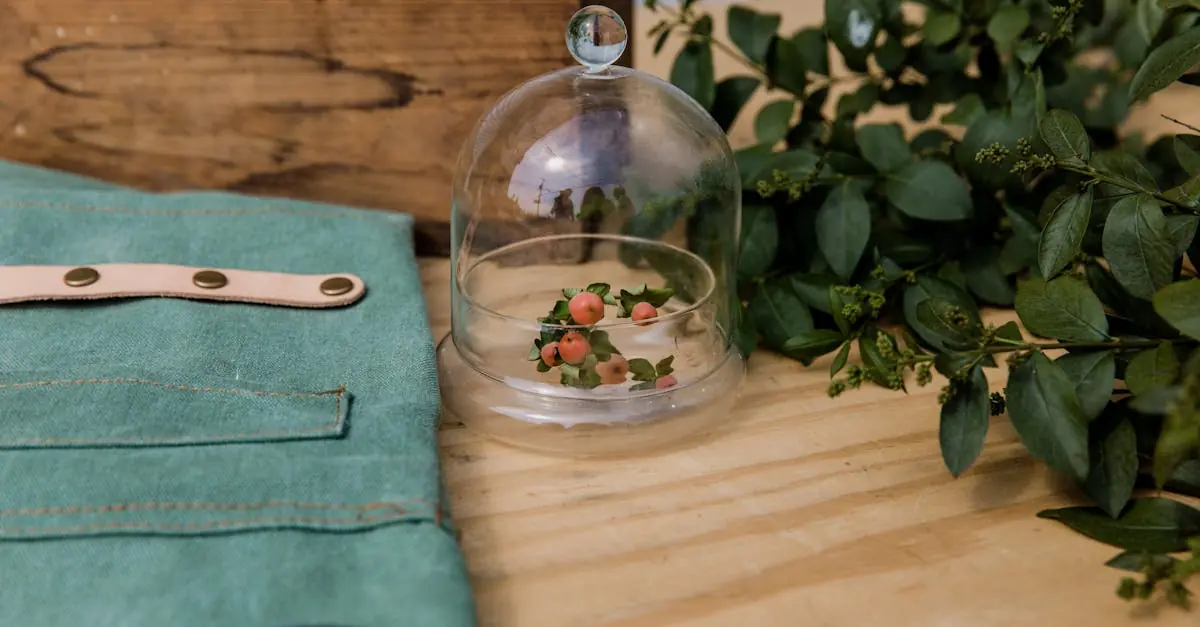Gardening fabric might not sound like the most exciting topic, but it’s about to become your garden’s best-kept secret. Imagine a world where weeds don’t stand a chance and your plants thrive like they’re on a spa retreat. That’s the magic of gardening fabric. It’s like giving your garden a superhero cape—protecting it from pesky weeds while allowing water and nutrients to flow freely.
Table of Contents
ToggleOverview of Gardening Fabric
Gardening fabric serves as an essential component in maintaining a healthy garden environment. This material, commonly known as landscape fabric, undergoes manufacturing with durable fibers, providing long-lasting performance. Its primary function involves blocking weeds while allowing essential water and nutrients to penetrate the soil.
The application of gardening fabric varies in types, including woven and non-woven options. Woven fabric consists of interlaced fibers, ensuring superior drainage. Non-woven fabric, crafted with bonded fibers, offers excellent filtration and retains moisture. Both types contribute to soil health and plant growth.
Installing gardening fabric contributes significantly to reduced maintenance efforts. By preventing weed growth, it encourages plants to thrive without competition for resources. Many gardeners appreciate the time saved in weeding, enabling a focus on nurturing plants.
In terms of versatility, gardening fabric supports various applications. This material suits vegetable gardens, flower beds, and pathways. Its adaptability makes it a favored choice among both amateur and professional gardeners.
Cost efficiency also stands out as a noteworthy aspect. While the initial investment may seem significant, the long-term benefits in reduced labor and improved plant health justify the expense. Many users recognize that effective gardening fabric can last several years, presenting excellent value.
As gardening fabric continues to evolve with advancements in materials, its effectiveness becomes more pronounced. Innovations have led to lighter and more durable options, enhancing the gardening experience. Understanding these attributes positions gardeners to make informed decisions for their gardens.
Types of Gardening Fabric
Gardening fabric comes in several types, each designed for specific gardening needs. Understanding these options helps gardeners choose the best fabric for their projects.
Landscape Fabric
Landscape fabric serves as a versatile barrier against weeds while allowing water and nutrients to pass through. Made from durable materials, it provides excellent drainage. Gardeners often use it in flower beds or around trees. The fabric helps maintain soil temperature and moisture levels, promoting healthy plant growth. Installation is straightforward, making it a popular choice among both novices and experienced gardeners. Many find that landscape fabric reduces maintenance time, allowing them to enjoy their gardens without excessive weeding.
Weed Control Fabric
Weed control fabric is specifically designed to prevent competing plant growth. It effectively blocks sunlight, inhibiting weed germination and growth. This type of fabric often has a heavier weight, which enhances its ability to suppress weeds. Gardeners frequently place it under mulch or rock to enhance effectiveness. Maintaining an attractive garden becomes easier with this fabric, as it minimizes the need for manual weeding. Long-lasting and durable, weed control fabric often withstands various weather conditions, ensuring reliable performance.
Planting Fabric
Planting fabric specializes in supporting the growth of specific plants while facilitating water and air exchange. Often used in nursery settings, this fabric helps seedlings establish robust root systems. It can be cut to fit various planting layouts, making it adaptable to different garden types. Many gardeners appreciate its lightweight nature, which simplifies handling during planting. Additionally, planting fabric is designed to break down slowly, enriching the soil over time as it composts. This gradual decomposition contributes to overall soil health, benefiting the plants grown above it.
Benefits of Using Gardening Fabric
Gardening fabric offers numerous advantages that enhance the overall health of gardens. It serves as an effective solution for common gardening challenges.
Weed Prevention
Weed prevention stands out as a primary benefit of gardening fabric. This material acts as a barrier against invasive plants that compete for nutrients and water. By blocking sunlight, it inhibits weed germination, allowing desired plants to flourish. Many gardeners appreciate the ease this fabric provides, reducing the time spent on weeding. Long-lasting options have proven effective for several growing seasons, maximizing gardening efforts.
Soil Moisture Retention
Soil moisture retention significantly improves with the use of gardening fabric. This material allows water to permeate the ground while preventing excess evaporation. As a result, plants receive consistent moisture, promoting healthier growth. Various types of gardening fabrics offer different moisture retention capabilities, catering to diverse gardening needs. Many gardeners find that this benefit minimizes the frequency of watering, conserving both time and resources.
Temperature Regulation
Temperature regulation plays a crucial role in plant health, and gardening fabric aids in maintaining optimal soil temperatures. This material creates insulation against temperature fluctuations, protecting root systems during extreme conditions. By moderating soil temperature, gardening fabric supports steady plant growth throughout the seasons. Experienced gardeners often emphasize this benefit, noting its impact on overall garden vitality. The right fabric helps ensure plants thrive in varying climates, leading to greater harvests and blooms.
How to Use Gardening Fabric
Utilizing gardening fabric effectively leads to healthier gardens with minimal effort. Proper installation and maintenance practices play crucial roles in achieving optimal results.
Installation Tips
Choose a clean, flat area for better adherence of the fabric. Lay the gardening fabric with the appropriate side facing up; the woven side typically allows for better drainage, while the non-woven side excels in moisture retention. Overlap edges by at least six inches to prevent weed growth in seams. Secure the fabric with landscape pins, spaced every two feet for stability. Cut the fabric to fit around plant bases or garden features, ensuring adequate coverage. For pathways or around trees, extend the fabric several inches beyond the planting area to create a barrier against invasive species. Adjustments during installation ensure effective performance.
Maintenance Practices
Regular inspections maintain the fabric’s effectiveness and garden health. Remove debris and organic matter regularly to prevent weed establishment on top of the fabric. Check edges and seams for signs of wear or damage, making necessary repairs promptly. Watering should be done directly onto the fabric to maximize efficiency; avoid surface watering that may lead to moisture accumulation. During planting, consider additional mulch to suppress weed growth while retaining moisture. Monitor plant health and fabric condition periodically throughout the growing season to enhance longevity and reduce labor. Adhering to these practices keeps the garden thriving continuously.
Gardening fabric stands out as an essential ally for anyone looking to cultivate a healthy and thriving garden. Its ability to suppress weeds while allowing vital resources to reach plants makes it a smart investment. With various types available gardeners can choose the right fabric to suit their specific needs.
The long-term benefits of reduced maintenance and improved plant health far outweigh the initial costs. By implementing proper installation and maintenance practices gardeners can ensure that their gardening fabric continues to perform effectively for years to come. Embracing this innovative solution not only enhances garden aesthetics but also supports sustainable gardening practices.




